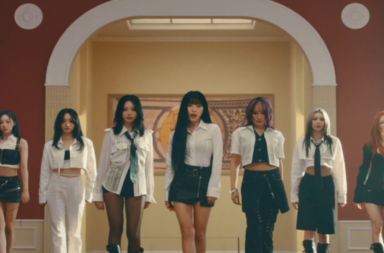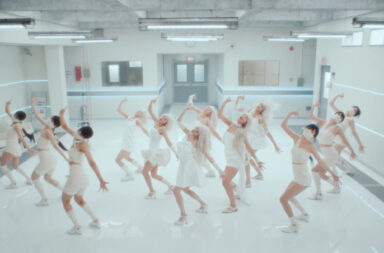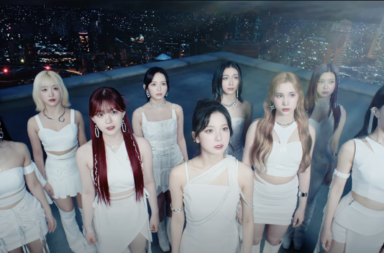
As ‘out there’ as the latest generation of K-pop may seem, every now and then there comes a release that encourages audiences to question that sentiment (no matter the generation): how daring are idols’ musical endeavors, really? And how might they compare to previous generations?
Expected or not, Enhypen are the latest fourth generation group to pose this question, through their latest comeback “Bite Me.” While conceptually “Bite Me” is nothing entirely new for the group (they already leaned into the vampire concept for their debut and comebacks like “Drunk-Dazed”), it is certainly a leap into more mature territory for Enhypen. It’s nothing entirely new for K-pop of years’ and generations’ past either, and if anything is a callback to more provocative relics of second and even third generation K-pop.
The very title of the track is enough to paint a decidedly more grown-up picture of the members, whose ages now span between 17 through 21 in international age. The story the lyrics tell follows suit: they’ve fallen in love, but the only way they can seal their fate with the person they’re destined to be with is if that person claims their blood, through a bite.
It’s a tale as old as time, quite literally. The vampire concept’s blood has always run deep through K-pop, harkening back to second and third generations acts like VIXX, EXO, Vav, and more. Enhypen themselves have already woven plenty of vampire lore into their comebacks, but “Bite Me” is noticeably different. Yes, it technically follows the lore of the group’s very own webtoon series, “DARK MOON: THE BLOOD ALTAR,” released by Hybe earlier this year. And yes, there are several moments that signify this lore, like the opening scene in which the members magically float down and transform into seven coffins. But despite this foundational layer of storytelling, the “Bite Me” MV actually focuses much more on performance and aesthetic aspects, rather than the actual story the song looks to tell.
Vampirisms aside, “Bite Me”’s heavier focus on its performance moments, along with other throwback visual cues, make it very second-generation K-pop in nature. The loudest callback to the second generation and perhaps the boldest choice in the MV is the decision to incorporate female dancers — as the members’ partners — into the choreography. The dancers join Enhypen during the chorus scenes of the MV, donning white and black outfits and black bandanas to cover their faces. In several swift and nearly sensual moments, the female dancers gesture toward the members’ necks, continuously calling back to the song’s titular line. At one point, the Enhypen members place their hands on the small of their partners’ backs, dipping them for just a short moment.
For avid listeners and viewers of fourth-generation K-pop content, even the use of partner dancers who are not a part of the immediate group, let alone of the opposite sex, may be shocking in and of itself. The sultriness of their movements takes it even further up a notch. With partner choreographies rarely (if at all) being an option in fourth-generation K-pop, unlike with the second or third generation, “Bite Me” boldly breaks that mold, while simultaneously shattering a barrier that was once nonexistent in the industry.
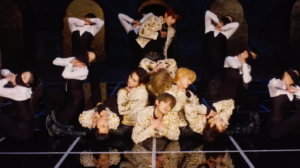
In terms of the MV’s visual elements and progression of its storyline, or lack thereof, “Bite Me” also calls back to an earlier moment in the industry when MVs weren’t overtly shrouded in complex lore. The lore exists here in “Bite Me,” but visual aesthetics take center stage. The MV’s visual cues don’t take the song’s lyrics too literally: There are no vampire fangs, no drawing of blood, no biting. Instead, the members find themselves performing on dark stages, backlit by a singular spotlight so that only their silhouettes can be seen amidst a blueish-black tinge of color. In other moments, they wear pearl-laden jackets and vests, again performing the choreography, but on the grounds of a Roman amphitheater.
In one standout scene, during the track’s addictive rap break (“Oh, oh, oh my god/This blood’s pumping crazy”), the members and dancers perform the corresponding moments of the choreography on a shiny black floor surrounded by Roman ruins. However, rather than the spotlight illuminating the group from the front, it shines on them from the back, casting their enlarged shadows on the ruins around them. It’s haunting and eerie, just like the choreography and vocals during this part of the track. It also avoids the overproduced and filtered nature of many fourth-generation choreography scenes in MVs, instead pointing back to simpler and differently-styled times.
While all of these elements are bold in the sense that most newer acts don’t dare to attempt to liken their MVs to those of second-generation K-pop, they only go so far as “Bite Me” progresses. For one, while the track also has features of second-generation K-pop, — like its early 2000s pop-meets-R&B melody and rhythm, and drawn-out vocal spin during the surprise rap breakdown between the pre-chorus and chorus — its structure ultimately causes it to fall flat. As catchy as the rap breakdown is, it loses its shock value and intrigue as it plays again throughout the song. While the breakdown does help to build anticipation for the chorus, it again falls flat when “Bite Me” ultimately skips over its potential for a bridge, instead repeating the chorus again and succumbing to a prolonged R&B-esque outro.
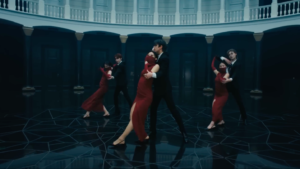
As the melody heads nowhere but the same direction three times over, the boldness of the MV’s visual and performance elements lose their magic too. Perhaps additional focus on the track’s narrative could have helped see its vision to fruition, but without a complete-sounding song, “Bite Me” as a whole ultimately feels half-baked.
Still, Enhypen push themselves outside the confines of their own generation’s comfort zones in “Bite Me,” posing the question to audiences: how far will you let us go? While the answer for some fourth-generation fans may be ‘not this far,’ it will be telling to see what impact this comeback has on acts to follow.
(Webtoons, YouTube. Lyrics via YouTube. Images via Hybe/Belift Lab.)
